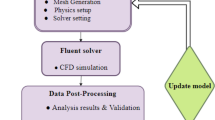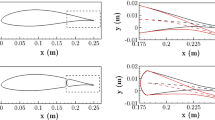Abstract
A 2D unsteady numerical simulation with dynamic and sliding meshing techniques was conducted to solve the flow around a threeblade Vertical axis wind turbine (VAWT). The circular wakes, strip-like wakes and the shedding vortex structures interact with each other result in an extremely unstable performance. An airfoil with a trailing edge flap, based on the NACA0012 airfoil, has been designed for VAWT to improve flow field around the turbine. Strategy of flap control is applied to regulate the flap angle. The results show that the flapped airfoil has an positive effect on damping trailing edge wake separation, deferring dynamic stall and reducing the oscillating amplitude. The circular wake vortices change into strip vortices during the pitch-up interval of the airfoils. Examination of the flow details around the rotating airfoil indicates that flap control improves the dynamic stall by diminishing the trend of flow separation. Airfoil stall separation has been suppressed since the range of nominal angle of attack is narrowed down by an oscillating flap. Vortices with large intensity over rotational region are reduced by 90 %. The lift coefficient hysteresis loop of flapped airfoil acts as an O type, which represents a more stable unsteady performance. With flap control, the peak of power coefficient has increased by 10 % relative to the full blade VAWT. Obviously, the proposed flapped airfoil design combined with the active flow control significantly has shown the potential to eliminate dynamic stall and improve the aerodynamic performance and operation stability of VAWT.
Similar content being viewed by others
References
R. K. Singh, M. R. Ahmed, M. A. Zullah and Y. H Lee, Design of a low Reynolds number airfoil for small horizontal axis wind turbines, Renewable Energy, 42 (1) (2012) 66–76.
R. Howell, N. Qin, J. Edwards and N. Durrani, Wind tunnel and numerical study of a small vertical axis wind turbine, Renewable Energy, 35 (2) (2010) 412–422.
L. A. Danao, O. Eboibi and R. Howell, An experimental investigation into the influence of unsteady wind on the performance of a vertical axis wind turbine, Applied Energy, 107 (4) (2013) 403–411.
S. Eriksson, H. Bernhoff and M Leijon, Evaluation of different turbine concepts for wind power, Renewable & Sustainable Energy Reviews, 12 (5) (2008) 1419–1434.
S. C. Ferreira, G. V. Kuik, G. V. Bussel and F. Scarano, Visualization by PIV of dynamic stall on a vertical axis wind turbine, Experiments in Fluids, 46 (1) (2008) 97–108.
L. W. Carr, Progress in analysis and prediction of dynamic stall, J. of Aircraft, 25 (1) (1988) 6–17.
P. P. Friedmann, M. D. Terlizzi and T. F. Myrtle, New developments in vibration reduction with actively controlled trailing edge flaps, Mathematical & Computer Modelling, 33 (10) (2001) 1055–1083.
S. R. Viswamurthy and R. Ganguli, An optimization approach to vibration reduction in helicopter rotors with multiple active trailing edge flaps, Aerospace Science & Technology, 8 (3) (2004) 185–94.
C. K. Maucher, B. A. Grohmann, P. Danker, A. Altmikus, F. Jensen and H. Baier, Actuator design for the active trailing edge of a helicopter rotor blade, Proceedings of the 33rd European Rotorcraft Forum, Kazan, Russia (2007) 11–13.
A. Mishra, J. Sitaraman, J. D. Baeder and D. G. Opoku, Computational investigation of trailing edge flap for control of vibration, The 25th AIAA Applied Aerodynamics Conference, Miami, Florida, USA (2007) 1–25.
E. A. Bossanyi, Individual blade pitch control for load reduction, Wind Energy, 6 (2) (2003) 119–28.
T. J. Larsen, H. A. Madsen and K. Thomsen, Active load reduction using individual pitch: based on local blade flow measurements, Wind Energy, 8 (1) (2005) 67–80.
T. Buhl, M. Gaunaa and C. Bak, Potential load reduction using airfoils with variable trailing edge geometry, J. of Solar Energy Engineering, 127 (4) (2005) 503–516.
T. K. Barlas and G. V. Kuik, Aeroelastic modelling and comparison of advanced active flap control concepts for load reduction on the upwind 5MW wind turbine, Proceedings of the 2009 European Wind Energy conference & Exhibition, Marseille, French (2009) 1–12.
I. Abdallah, Advanced load alleviation for wind turbines using adaptive trailing edge flaps: sensoring and control, Denmark Technical University, Roskilde, Denmark (2010).
M. A. Lackner and G. V. Kuik, A comparison of smart rotor control approaches using trailing edge flaps and individual pitch control, Wind Energy, 13 (2) (2010) 117–134.
H. Markou, P. B. Andersen and G. C, Larsen, Potential load reductions on megawatt turbines exposed to wakes using individual-pitch wale compensator and trailing-edge flaps, Wind Energy, 14 (7) (2011) 841–857.
W. J. Zhu, W. Z. Shen and J. N. Serrensen, Modeling of airfoil trailing edge flap with immersed boundary method, The 2011 International Conference on Offshore Wind Energy and Ocean Energy, Beijing, China (2011) 1–9.
T. Lutz, A. Wolf, W. Wiirz and J. G. Jeremiasz, Design and verification of an airfoil with trailing edge flap and unsteady wind tunnel tests, UPWIND Technical Report, Stuttgart, Germany (2011).
N. Troldborg, Computational study of the riso airfoil with a hinged flap providing variable trailing edge geometry, Wind Engineering, 29 (2) (2005) 89–113.
G. K. Tan, G. X. Shen and W. H. Su, Experimental investigation on the aft-element flapping of a two-element airfoil at high attack angle, J. of Experiments in Fluid Mechanics, 21 (3) (2007) 1–7.
Q. Xiao, W. Liu and A. Incecik, Flow control for VATT by fixed and oscillating flap, Renewable Energy, 51 (2013) 141–152.
I. Paraschivoiu, Wind turbine design: with emphasis on darrieus concept, Polytechnic International Press, Montreal, Canada (2002).
J. C. Hunt, A. A Wray and P. Moin, Eddies stream and convergence zones in turbulent flows, Proceedings of the 1988 Summer Program, California, USA (1998) 193–208.
Author information
Authors and Affiliations
Corresponding author
Additional information
Recommended by Associate Editor Kyu Hong Kim
Yang Yang is a Ph.D. candidate at University of Shanghai for Science and Technology. His research area is wind turbine blade design and flow control.
Chun Li is currently a Professor at University of Shanghai for Science and Technology. His research fields include the flow control of wind farm, stall of VAWT and aeroelasticity of wind turbine.
Rights and permissions
About this article
Cite this article
Yang, Y., Li, C., Zhang, W. et al. Investigation on aerodynamics and active flow control of a vertical axis wind turbine with flapped airfoil. J Mech Sci Technol 31, 1645–1655 (2017). https://doi.org/10.1007/s12206-017-0312-0
Received:
Revised:
Accepted:
Published:
Issue Date:
DOI: https://doi.org/10.1007/s12206-017-0312-0




